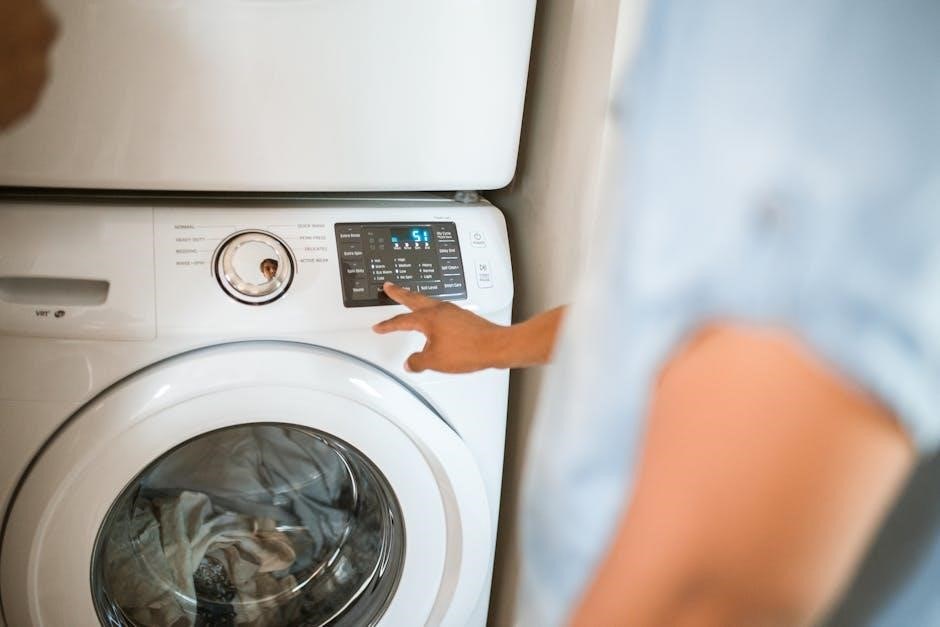The introduction to power cooker operating instructions begins with understanding the basics of power cooker usage and safety precautions to ensure proper functioning and maintenance of the device always.
Importance of Reading the Manual
Reading the power cooker manual is crucial for users to understand the device’s features and operating instructions. The manual provides detailed information on safety precautions, usage guidelines, and troubleshooting tips. By reading the manual, users can ensure proper installation, maintenance, and operation of the power cooker. This helps to prevent accidents, reduces the risk of damage, and extends the lifespan of the device. Additionally, the manual includes warranty information, parts lists, and customer support contacts. It is essential to read the manual thoroughly before using the power cooker to avoid any potential hazards or issues. The manual is usually available in multiple languages, including English, and can be downloaded from the manufacturer’s website or obtained from authorized dealers. Users should always refer to the manual for guidance on using their power cooker effectively and safely. The manual is a valuable resource for power cooker owners.
Availability of Power Cooker Manuals
Power cooker manuals are widely available from various sources, including the manufacturer’s website, authorized dealers, and online marketplaces. Users can search for manuals by model number or product name to find the relevant documentation. Many manufacturers also provide digital versions of their manuals, which can be downloaded or viewed online. Some popular websites, such as Manuals.co.uk, offer a comprehensive collection of power cooker manuals from various brands. These manuals are often available in multiple languages, including English, and can be accessed free of charge. Users can also contact the manufacturer’s customer support team to request a manual or obtain additional information about their power cooker. Overall, power cooker manuals are readily available, making it easy for users to access the information they need to operate and maintain their device. The manuals are usually updated regularly to reflect any changes.

Understanding Power Cooker Models
Power cooker models vary in size, features, and functionality, including the popular PC-WAL1 and PC-WAL2 models always available online for customer reference and guidance purposes only.
Popular Power Cooker Models
There are several popular power cooker models available in the market, including the PC-WAL1 and PC-WAL2, which are known for their advanced features and user-friendly interface. These models are widely used for cooking a variety of dishes, including soups, stews, and grains. The PC-WAL1 model is a 6-quart digital pressure cooker that comes with a range of preset settings, making it easy to cook a variety of foods. The PC-WAL2 model, on the other hand, is an 8-quart pressure cooker that is ideal for large families or for those who want to cook in bulk. Both models are highly rated by customers and are available for purchase online. They are also backed by a comprehensive warranty and dedicated customer support. Overall, these popular power cooker models are a great choice for anyone looking to cook healthy and delicious meals quickly and easily.
Differences Between Models
The differences between power cooker models are significant, with each model offering unique features and capabilities. The size of the cooker is one of the main differences, with some models having a larger capacity than others. For example, the PC-WAL1 model has a 6-quart capacity, while the PC-WAL2 model has an 8-quart capacity. Additionally, some models may have more preset settings or advanced features such as pressure control or delayed start. The user interface and design of the models may also vary, with some models having a more intuitive interface or a more compact design. Understanding these differences is important to choose the right model for your needs. The various models are designed to cater to different cooking requirements and preferences, making it essential to research and compare the features before making a purchase.

Safety Features of Power Cookers
Safety features of power cookers include lid safety devices and other built-in mechanisms always protecting users from accidents and injuries effectively every time.
Lid Safety Device
The lid safety device is a crucial feature of power cookers, designed to prevent accidents and injuries. This device prevents pressure buildup if the lid is not closed properly, ensuring safe and secure cooking. The lid safety device also prevents the lid from opening until all pressure is released, allowing users to safely open the cooker. According to the user manual, the lid safety device is an essential component of the power cooker, and it is important to understand how it works to ensure safe and effective use. The device is typically automatic, and it does not require any manual intervention, making it a convenient and reliable safety feature. The lid safety device is a standard feature in most power cookers, including the Power Cooker PC-WAL1 and other popular models, and it provides an additional layer of safety and protection for users.
Other Safety Features
Power cookers have several other safety features that work together to provide a safe cooking experience. These features include automatic shut-off, overheating protection, and secure locking mechanisms. The automatic shut-off feature turns off the cooker when the cooking cycle is complete, preventing overcooking and reducing the risk of accidents. Overheating protection prevents the cooker from exceeding a certain temperature, reducing the risk of damage or injury. Secure locking mechanisms ensure that the lid is securely closed during cooking, preventing accidental openings and reducing the risk of scalds or burns. These safety features are designed to work together to provide a safe and secure cooking experience, and they are an essential part of power cooker operating instructions. By understanding these features, users can cook with confidence and safety. The user manual provides more information on these safety features and how to use them effectively.

Operating Instructions for Power Cookers
Operating instructions for power cookers provide step-by-step guidance on safe and effective usage always using the device.
General Operating Instructions
General operating instructions for power cookers typically include plugging in the device, adding food and liquid, and setting the desired cooking time and temperature.
The user manual provides detailed guidance on how to use the power cooker, including instructions on how to prepare food, cook, and clean the device.
The general operating instructions also cover safety precautions, such as ensuring the lid is properly closed and the device is placed on a stable surface.
Additionally, the instructions may include troubleshooting tips and maintenance recommendations to ensure the power cooker continues to function properly.
By following the general operating instructions, users can ensure safe and effective use of their power cooker, and achieve optimal cooking results.
The instructions are usually provided in the user manual, which is available online or included with the purchase of the power cooker.
Specific Operating Instructions for Each Model
Specific operating instructions for each power cooker model are crucial for optimal performance and safety.
The instructions vary depending on the model, with some featuring advanced settings and others having more basic controls.
For example, the Power Cooker PC-WAL1 has a digital interface with preset buttons, while the PC-WAL2 has a more manual control system.
Understanding the unique features and settings of each model is essential for achieving the best results.
The user manual for each model provides detailed guidance on how to use the specific features and functions.
By following the specific operating instructions for each model, users can unlock the full potential of their power cooker and enjoy a wide range of cooking options.
The specific instructions help to prevent accidents and ensure safe operation of the power cooker.

Troubleshooting and Maintenance
Maintenance and troubleshooting are essential for power cooker longevity and optimal performance always.
Common Issues and Solutions
Common issues with power cookers include faulty lids, clogged valves, and malfunctioning pressure sensors. To resolve these issues, users can refer to the user manual or contact the manufacturer’s customer support. The user manual provides detailed troubleshooting guides and repair instructions. Additionally, regular maintenance such as cleaning and descaling can help prevent common issues. It is also important to follow proper usage and safety guidelines to avoid accidents and ensure optimal performance. By following these tips, users can enjoy safe and efficient cooking with their power cookers. The solutions to common issues are often simple and easy to implement, and can help extend the lifespan of the power cooker. Proper care and maintenance are essential for optimal performance and longevity of the device. Regular checks and maintenance can help identify potential issues before they become major problems.
Maintenance Tips
To maintain the power cooker, it is essential to clean it regularly, especially after each use. The user manual provides guidelines on how to clean and descale the power cooker. Regular cleaning helps to prevent the buildup of food residue and mineral deposits. It is also important to check the power cooker’s seals and gaskets regularly to ensure they are in good condition. Additionally, the power cooker’s heating element and sensors should be checked periodically to ensure they are functioning properly. By following these maintenance tips, users can help extend the lifespan of their power cooker and ensure it continues to function efficiently and safely. Regular maintenance also helps to prevent common issues and ensures the power cooker continues to perform optimally. Proper maintenance is crucial for the longevity and performance of the power cooker.

No Responses